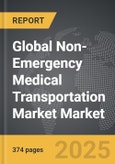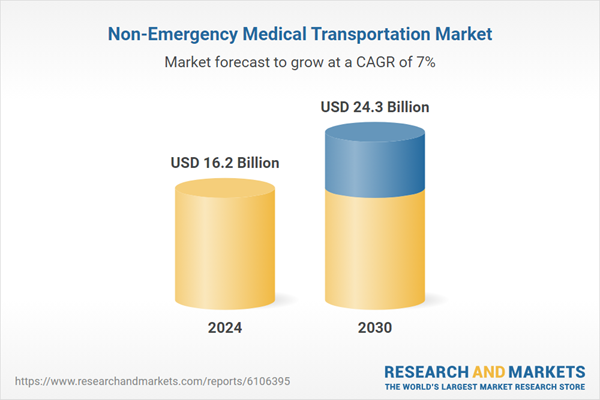Global Non Emergency Medical Transportation Market - Key Trends & Drivers Summarized
How Are Regulatory Shifts and Health Policies Reshaping Non Emergency Medical Transportation?
Non-emergency medical transportation (NEMT) services provide vital mobility for patients who need assistance reaching appointments but do not require emergency care. Over the past few years, health policies have increasingly recognized reliable NEMT as essential to improving access and reducing hospital readmissions. Many public and private health insurers now include NEMT in benefit packages to ensure equitable care delivery. New regulations around Medicaid and value based care emphasize performance metrics - such as timeliness, safety, and patient satisfaction - pushing providers to upgrade services and infrastructure.As healthcare systems transition from fee-for-service models to outcome-based payment, NEMT providers must demonstrate efficiency and quality standards. Licensing requirements, data transparency mandates, and safety audits have raised the bar for operational readiness. This regulatory environment encourages investment in fleet maintenance, driver training, and service monitoring platforms. It also prompts collaboration between healthcare networks, payers, and NEMT agencies to align on performance goals and agreed-upon standards.
What Role Is Technology Playing in Enhancing Service Efficiency and Safety?
Technology has become a cornerstone of modern NEMT operations. Sophisticated booking systems, often with cloud-based dashboards, allow coordination across providers and care settings. Real-time GPS monitoring, digital check-in features, and automated arrival notifications provide visibility into driver location and patient status. AI-driven routing and dynamic dispatch algorithms help minimize wait times, reduce idle mileage, and optimize resource allocation.Equipped vehicles now integrate safety technology, such as wheelchair securement systems, driver-assist cameras, and emergency alert functions. Electronic logging tools record trip details and patient interactions to comply with regulatory documentation and audit requirements. Mobile apps offer patients and caregivers easy access to trip details, reminders, and driver credentials. These integrated systems are improving trust, reducing missed appointments, and helping agencies manage higher service volumes with fewer resources.
How Are Revenue Models and Partnerships Evolving in the NEMT Sector?
Traditional NEMT providers often relied on contracts from Medicaid and hospital networks. Today, innovative models are emerging alongside those partnerships. Ride-share integration, shared mobility programs, and broker systems are reshaping how services are delivered and reimbursed. Through app-based platforms, agencies can dispatch rides on demand while maintaining compliance with medical transport requirements.Some NEMT providers are forming alliances with telehealth platforms, care-at-home programs, and chronic care management services. These partnerships allow for bundled care delivery, where transportation is coordinated alongside remote monitoring or in-home nursing visits. Outcome-based reimbursement models reward reduced no-show rates and better care continuity. Investment in NEMT technology startups has also attracted venture funding, enabling market entrants to scale rapidly through platform-driven efficiency and innovative service offerings.
Growth in the non emergency medical transportation market is driven by several factors.
Expanding coverage of NEMT services in public insurance plans has increased demand and funding. Providers are adopting advanced digital dispatch, routing, and tracking software to improve service efficiency and regulatory compliance. Partnerships with ride-hailing networks and telehealth platforms are supporting new integrated care offerings. Focus on patient outcomes and appointment attendance is motivating payers to reimburse more extensively for reliable NEMT services. Regulatory emphasis on accessible, safe medical transport continues encouraging investment in driver training and accessible vehicle fleets. Meanwhile, demand for convenient, on demand mobility solutions, especially among aging and mobility-impaired populations, is strengthening long term market growth.Report Scope
The report analyzes the Non-Emergency Medical Transportation market, presented in terms of market value (US$). The analysis covers the key segments and geographic regions outlined below:- Segments: Service (Private Pay Patient Transportation Service, Insurance Backed Patient Transportation Service, Courier Services); Application (Dialysis Application, Routine Doctor Visits Application, Mental Health Related Appointments Application, Rehabilitation Application); End-Use (Hospitals & Clinics End-Use, Nursing Homes End-Use, Homecare Settings End-Use, MCO & State Agencies End-Use, Healthcare Payers End-Use).
- Geographic Regions/Countries: World; United States; Canada; Japan; China; Europe (France; Germany; Italy; United Kingdom; Spain; Russia; and Rest of Europe); Asia-Pacific (Australia; India; South Korea; and Rest of Asia-Pacific); Latin America (Argentina; Brazil; Mexico; and Rest of Latin America); Middle East (Iran; Israel; Saudi Arabia; United Arab Emirates; and Rest of Middle East); and Africa.
Key Insights:
- Market Growth: Understand the significant growth trajectory of the Private Pay Patient Transportation Service segment, which is expected to reach US$13.2 Billion by 2030 with a CAGR of a 6%. The Insurance Backed Patient Transportation Service segment is also set to grow at 8% CAGR over the analysis period.
- Regional Analysis: Gain insights into the U.S. market, valued at $4.4 Billion in 2024, and China, forecasted to grow at an impressive 10.8% CAGR to reach $5 Billion by 2030. Discover growth trends in other key regions, including Japan, Canada, Germany, and the Asia-Pacific.
Why You Should Buy This Report:
- Detailed Market Analysis: Access a thorough analysis of the Global Non-Emergency Medical Transportation Market, covering all major geographic regions and market segments.
- Competitive Insights: Get an overview of the competitive landscape, including the market presence of major players across different geographies.
- Future Trends and Drivers: Understand the key trends and drivers shaping the future of the Global Non-Emergency Medical Transportation Market.
- Actionable Insights: Benefit from actionable insights that can help you identify new revenue opportunities and make strategic business decisions.
Key Questions Answered:
- How is the Global Non-Emergency Medical Transportation Market expected to evolve by 2030?
- What are the main drivers and restraints affecting the market?
- Which market segments will grow the most over the forecast period?
- How will market shares for different regions and segments change by 2030?
- Who are the leading players in the market, and what are their prospects?
Report Features:
- Comprehensive Market Data: Independent analysis of annual sales and market forecasts in US$ Million from 2024 to 2030.
- In-Depth Regional Analysis: Detailed insights into key markets, including the U.S., China, Japan, Canada, Europe, Asia-Pacific, Latin America, Middle East, and Africa.
- Company Profiles: Coverage of players such as Altasciences, Antibody Solutions, ApconiX, BIOQUAL, Inc., Charles River Laboratories and more.
- Complimentary Updates: Receive free report updates for one year to keep you informed of the latest market developments.
Some of the 32 companies featured in this Non-Emergency Medical Transportation market report include:
- ABC Non-Emergency Medical Transportation LLC
- Acadian Ambulance Service, Inc.
- American Medical Response (AMR)
- Ambulnz
- CareSafe Transportation
- Coastal Medical Transportation Systems LLC
- Crothall Healthcare
- Elite Medical Transport
- Falck a/S
- Global Medical Response, Inc.
- Lifeline VMT
- LogistiCare Solutions (ModivCare)
- London Medical Transportation Systems Inc.
- MediTrans
- MTM, Inc.
- Ridesharing Health (Uber Health/Lyft Health)
- Southeastrans, Inc.
- Transdev Group SA
- Veyo LLC
- Xpress Transportation
This edition integrates the latest global trade and economic shifts into comprehensive market analysis. Key updates include:
- Tariff and Trade Impact: Insights into global tariff negotiations across 180+ countries, with analysis of supply chain turbulence, sourcing disruptions, and geographic realignment. Special focus on 2025 as a pivotal year for trade tensions, including updated perspectives on the Trump-era tariffs.
- Adjusted Forecasts and Analytics: Revised global and regional market forecasts through 2030, incorporating tariff effects, economic uncertainty, and structural changes in globalization. Includes historical analysis from 2015 to 2023.
- Strategic Market Dynamics: Evaluation of revised market prospects, regional outlooks, and key economic indicators such as population and urbanization trends.
- Innovation & Technology Trends: Latest developments in product and process innovation, emerging technologies, and key industry drivers shaping the competitive landscape.
- Competitive Intelligence: Updated global market share estimates for 2025, competitive positioning of major players (Strong/Active/Niche/Trivial), and refined focus on leading global brands and core players.
- Expert Insight & Commentary: Strategic analysis from economists, trade experts, and domain specialists to contextualize market shifts and identify emerging opportunities.
Table of Contents
Companies Mentioned (Partial List)
A selection of companies mentioned in this report includes, but is not limited to:
- ABC Non-Emergency Medical Transportation LLC
- Acadian Ambulance Service, Inc.
- American Medical Response (AMR)
- Ambulnz
- CareSafe Transportation
- Coastal Medical Transportation Systems LLC
- Crothall Healthcare
- Elite Medical Transport
- Falck a/S
- Global Medical Response, Inc.
- Lifeline VMT
- LogistiCare Solutions (ModivCare)
- London Medical Transportation Systems Inc.
- MediTrans
- MTM, Inc.
- Ridesharing Health (Uber Health/Lyft Health)
- Southeastrans, Inc.
- Transdev Group SA
- Veyo LLC
- Xpress Transportation
Table Information
| Report Attribute | Details |
|---|---|
| No. of Pages | 374 |
| Published | December 2025 |
| Forecast Period | 2024 - 2030 |
| Estimated Market Value ( USD | $ 16.2 Billion |
| Forecasted Market Value ( USD | $ 24.3 Billion |
| Compound Annual Growth Rate | 7.0% |
| Regions Covered | Global |









